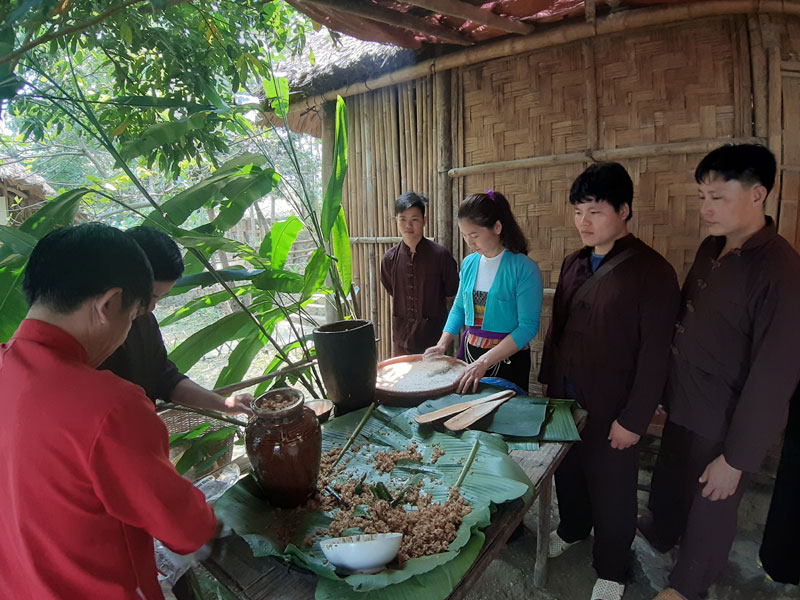
(HBO) - Ngoi hamlet in Ngoi Hoa commune, Tan Lac district is planned as a core zone in Hoa Binh lake national tourist area. Ngoi is a difficult hamlet of Hoa Binh province, with nearly 90 households. Ngoi village has great potential to develop various types of ecotourism, resort and cultural tourism.
 The people of Ngoi hamlet, Ngoi Hoa commune, Tan Lac district learn how to make traditional wine, building tourist products, meeting the needs of tourists.
The people of Ngoi hamlet, Ngoi Hoa commune, Tan Lac district learn how to make traditional wine, building tourist products, meeting the needs of tourists.
Ngoi hamlet still retains the traditional beauty with Muong houses on stilts. The village is located on Ngoi Hoa bay with thousands of hectares. In the hamlet, there is Dong Tien cave, ranked by the Ministry of Culture - Sports & Tourism as a place for the people who like exploring. Ngoi hamlet is recognized by Hoa Binh Provincial People's Committee as a local tourist destination in 2017.
Ngoi Hoa commune is identified as a core zone for tourism development in Hoa Binh lake area of Tan Lac district. Tan Lac District People's Committee has launched the Project "Preserving Muong ethnic cultural identity in association with the development of community tourism sites in Ngoi hamlet." Tan Lac district encourages investors to build tourism products associated with cultural identities. Making Ngoi hamlet become an attractive community tourism destination.
In the recent years, a lot of investors have paid attention and implemented investment projects in Ngoi Hoa commune. According to the development plan of Hoa Binh lake national tourism area until 2030, Ngoi Hoa subdivision has an area of 1,200 ha, planned to build ecological lakeside resorts, hotels, restaurants, parks, water sport area, ecological farm combined with resort...
This area has 7 investors who implement investment with a total area of 1,714,215 ha, total capital up to thousands of billion VND, such as: Ngoi Hoa eco-tourism resort project, capital registered investment of 474,719 billion VND; eco-tourism area V’Star - Ngoi Hoa project, capital registered investment of 125 billion VND...
Mr. Bui Van Binh, Secretary of Ngoi Hoa commune Party Committee said: With great opportunities to develop tourism, Ngoi Hoa commune has actively coordinated with other departments and investors to propagate local people to respond to the attractive investment policy in socio-economic development. People are trained to build tourism products. They change the thinking and ways to develop community tourism.
A diverse chain of eco-tourism and resort destinations concentrated in Hoa Binh city and the districts of Tan Lac, Da Bac, and Luong Son… Along with the launch of several key high-quality resort tourism projects, these developments have reshaped the landscape and enhanced the appeal of Hoa Binh as a travel destination.
Boasting diverse terrain, a mild climate, and rich natural resources, Cao Phong district is increasingly asserting its place on Vietnam’s tourism map, attracting both domestic and foreign visitors. The district is renowned for its stunning landscapes, majestic mountains, a crystal-clear hydropower lake, and the unique cultural identity of local ethnic groups.
With its pristine landscapes, unique cultural heritage of Muong ethnic minority, and an expanding range of visitor experiences, Tan Lac district of Hoa Binh has fast become a captivating destination for both domestic and international tourists.
Until now, Sung village in Cao Son commune, Da Bac district remains the only Dao ethnic community in Hoa Binh province to develop a community-based tourism model. Beyond its untouched natural landscapes, cultural identity serves as the cornerstone attraction for visitors.
Alongside the diverse cultural identities of the Kinh, Muong, Tay, Thai, Dao, and Mong ethnic people, Hoa Binh province is also renowned as the "capital" of the northwestern Vietnamese cuisine, offering unique and distinctive dishes. At festivals, during Lunar New Year (Tet), or on significant family or community occasions, special dishes are prepared, leaving a lasting impression on visitors.
A Phong Linh (Yellow Tabebuia) flower garden in Thang village, Thach Yen commune, Cao Phong district is currently in full bloom, drawing a large number of visitors.



 The people of Ngoi hamlet, Ngoi Hoa commune, Tan Lac district learn how to make traditional wine, building tourist products, meeting the needs of tourists.
The people of Ngoi hamlet, Ngoi Hoa commune, Tan Lac district learn how to make traditional wine, building tourist products, meeting the needs of tourists.